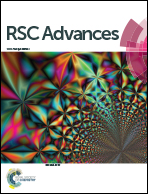Investigation of the domain structure and hierarchy in potassium–sodium niobate lead-free piezoelectric single crystals
Abstract
Recently, many techniques have been used to grow large K0.5Na0.5NbO3 (KNN) based single crystals. However, most of them required the use of a crucible, fluxes in the melt at high temperature and long process times that could lead to alkali volatilization or inclusion of impurities in the crystals. In this study, the floating zone method, which is especially suitable for compounds that melt incongruently or present volatile elements, is employed to study the microstructure of [011] oriented KNN crystals. Then, the domain structure and their relationships with piezoelectric properties in KNN are investigated using scanning electron microscopy (SEM), transmission electron microscopy (TEM) and piezo force microscopy (PFM). This study reveals self-organized and hierarchized domain structures on various length scales ranging from micrometer to nanometer scale in KNN crystals. First, parallel stripe-like microdomains of 6–7 μm wide, which contain themselves parallel stripes (1–4 μm wide), are observed using SEM. These domains have been confirmed by TEM. TEM observations have also shown the presence of additional zigzag sub-microdomains with 90 and 120° orientations, which are arranged inside these observed stripes. Moreover, high resolution TEM highlighted the presence of regular antiphase boundaries at the location of the domain walls, which are caused by the small misfits between the parameters of the different structures. Split spots on the FFT image attests of these phenomena. Additionally, PFM images showed also parallel stripe-like microdomains (3–4 μm wide), which contain sub-microdomains. These sub-microdomains consist of parallel stripes of 200–400 nm and zigzag nanodomains with 60, 90, 120 and 180° orientations. The local polarization switching test by PFM emphasized that the observed domain structures correspond well with ferroelectric domains, confirming through microstructural observations the ferroelectricity of KNN. The combination of SEM, TEM and PFM observations of orthorhombic KNN crystals have shown the correlation between microstructure, sub-microstructure and domain structures at different scales. The [011] oriented KNN crystal exhibited interesting piezoelectric properties such as kt of 0.47, d33 ∼ 60–80 pm V−1, εSr,33 of 123, dielectric losses (δe) of 0.07 but also high mechanical losses (δm) of 0.21 that can be induced by 90° domain walls moving under the influence of an electric field during poling.


 Please wait while we load your content...
Please wait while we load your content...